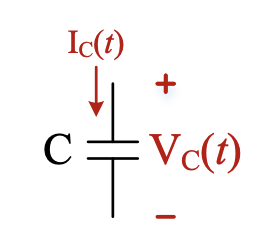Capacitors store energy in the electrostatic field of charge () on conductive plates separated by a distance.

Applying a voltage, forces a proportional charge imbalance of . This is analogous to storing energy in a stretched spring or placing a stretchy balloon membrane in a pipe.
This proportionality is called the capacitance () and states how much charge, , is pushed onto the capacitor for a given voltage, :
Taking the time derivative of both sides gives an relationship:
A bigger capacitor can store more for a given .
- Analogy: A bike tire has more less air () for a given pressure () versus a bouncy castle, which has significantly more air; so, the bike tire has less capacitance than the bouncy castle.